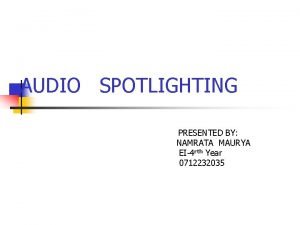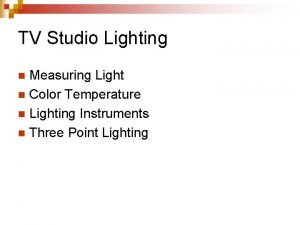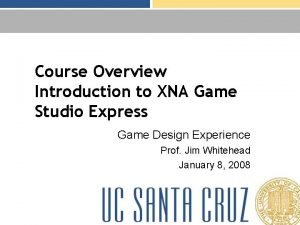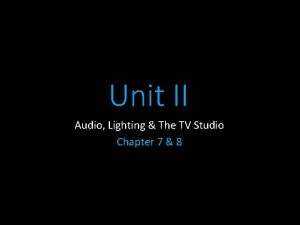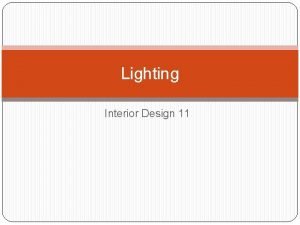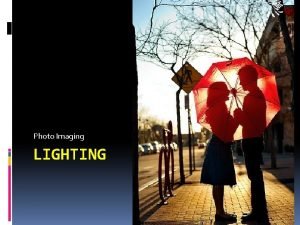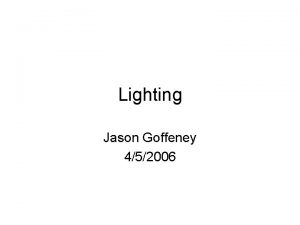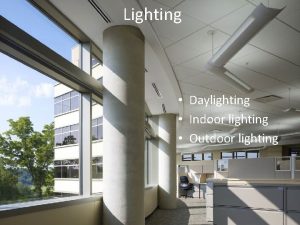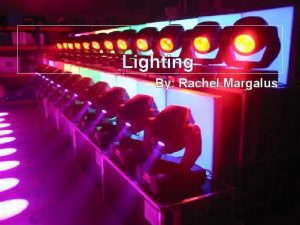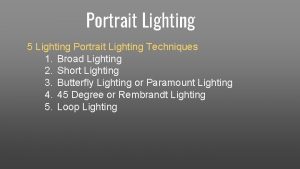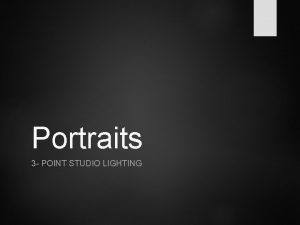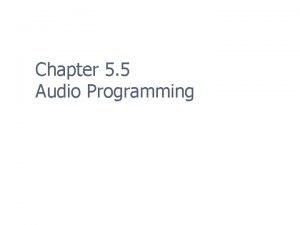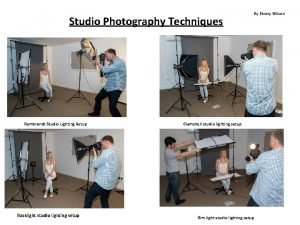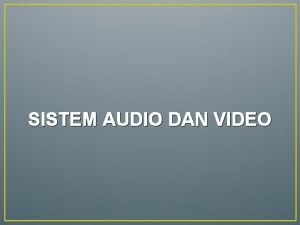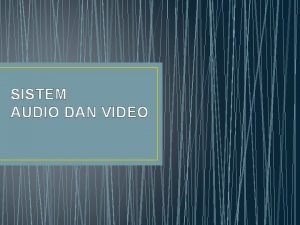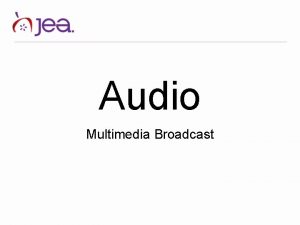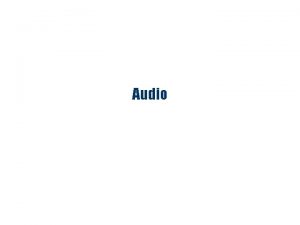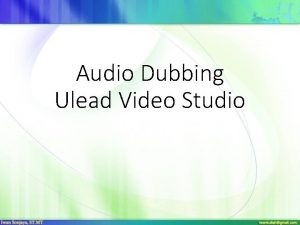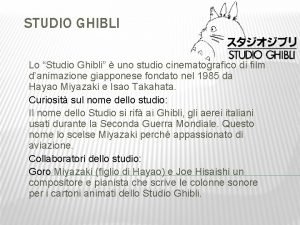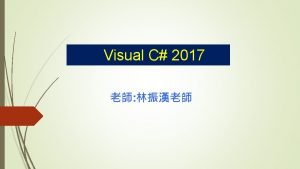Unit II Audio Lighting The TV Studio Chapter






























- Slides: 30

Unit II Audio, Lighting & The TV Studio Chapter 7 & 8

Audio & Sound Control Lesson 1

Audio Basics • In audio the sounds the microphone hears are transduced (transformed) into electric energy—the audio signal. This signal is made audible again through the loudspeaker. • The basic sound pickup tool is the microphone, or mic (pronounced “mike”). • Good audio requires that you know how to choose the right mic for a specific sound pickup—not an easy task when faced with the many choices available.

Types of Mics Dynamic Microphones • Dynamic microphones are well known for their versatility and their durability, but are not the best choice for reproducing high and low frequencies; dynamic microphones require significant energy to move the coil of wire and therefore lose definition at the extremes. • You use it for live vocals and recording • You work with relatively loud sound sources Ribbon Microphones • This extremely sensitive configuration picks up a wide range of frequencies and produces an extraordinarily rich representation of the original sound. These ribbon microphones are also sensitive to physical impacts and therefore are not considered portable and can be easily damaged by power overdrive. • You seek smooth, detailed sound • You want to capture the subtle nuances in a recording studio • You expect and appreciate subtle, sensitive sound Condenser Microphones • Condenser microphones are used for a variety of applications, making them an optimal compromise between the sound reproduction of ribbon microphones and the durability of dynamic microphones. • You need versatility because you work in a variety of applications for example speech as well as music • You like sound that is natural, clean and clear, with transparency and detail • You need exceptionally sensitive pickup, which requires phantom power for silent audio amplification

Dynamic VS. Condenser

Types of Microphones • The zone within which a microphone can hear well—is specified by its pickup pattern. • Its two-dimensional representation is called the polar pattern. • The omnidirectional mic hears equally well from all directions. Visualize the omnidirectional mic at the center of a sphere. The sphere itself represents the pickup pattern. • The unidirectional mic is designed to hear especially well from one direction—the front. Because the pickup pattern of a unidirectional mic is roughly heart-shaped, it is also called cardioid.

Mic Pick-up Patterns

Audio Cables • All professional microphones and camcorders use three-conductor cables (called balanced cables) with threeconductor XLR connectors. • They are relatively immune to outside interference from unwanted frequencies. With an XLR jack in a camcorder, you can use any professional audio cable to connect a high-quality microphone to the camera. • Most consumer microphones and small camcorders use the smaller RCA phono plug or the mini plug for their (unbalanced) cables. • You can, of course, also transport digital audio signals with a Fire. Wire (IEEE 1394) or an HDMI cable over short distances.

Types of Microphones • Please take the next couple of minutes and read through the handout I have given you. • Complete the follow-up questions once you have become familiar with the different types of microphones and pick-up patterns. • Please hand in the questions; this will be counted as a quiz.

Lesson 2 Intro to Garageband

How does music make you feel? ? • I will play 3 songs, for each of those song I would like you write down an emotion you feel when you listen to it. • What type of movie scene do you see in your head when you hear the music? ? ? • Discuss it with your partner. • Song 1 – 1: 40 • http: //www. youtube. com/watch? v=Ao. HSLw. Om. NS 8 • Song 2 - http: //www. youtube. com/watch? v=vb. Fm 1 H 9 y. Uhg&list=PL 9 PNd. K 4 Gvlqunr Ta. TUW 4 f 7 kf 5 Sm. PHt. MI 5&index=1 • Song 3 – 3: 25 • http: //www. youtube. com/watch? v=L 6 MPANg. IYcg

History of Music in Film • The majority of silent films were accompanied by anything from full orchestras to organists and pianists. Books of music were published to provide the accompanists with ideas for scene music, categorized by mood, event, or element. • Many of the films came with a "suggestion list" of what music to play in which scene. • Music continued to be a part of film and still today plays an influential part in the storytelling aspect of a film. • Music can serve several purposes that are either important on the emotional side of the movie or help/enhance the storytelling. • It is not only helpful but essential for any director/producer to keep the music in mind when planning/shooting the movie.

Learning Garage Band – Songs • http: //www. youtube. com/watch? v=8 Mf. RHi. VHXs. U &list=PL 919 D 238 C 5 B 8 CC 8 CB

Learning Garage Band - Loops http: //www. youtube. com/watch? v=1 xr_x. J 9 TM 00

Garageband • Now that we have watched the Garageband tutorials, you will have some time to become familiar with the program. • If you need to watch them again, they are located on my teacher page under the Unit II Tab. • For this activity please pick one of the following emotions: • • • Suspense/fear Happy Sad Relaxed Excited Anger • For the next 30 - 40 minutes, please try and create your own song. • Use at least 5 different loops to make a 30 second track. • Remember: songs in film are meant to evoke emotion or help with storytelling. For this activity have an emotion in mind BEFORE you begin to create your song. • YOU CANNOT JUST USE “JINGLES”- the premade songs from Garageband.

Chapter 7 • Please use the online book and complete the Chapter 7 quiz. • Chapter 7 is all about audio pick-up. • Knowing the different types of microphones will help you choose the best one if you would like to record your own song for your music video.

Lesson 3 “The Right Music For the Right Scene”

Garage Band Project • In pairs, you will choose one of the following scenes or trailers and create your own musical score to be the background music for the clip you selected. • Remember what we said music in film is primarily used for: To make the audience feel a certain way and enhance the storytelling aspect of the film. • • Trailer: Nightmare on Elm Street Trailer: 300 Scene: Indiana Jones – Stealing the Golden Head Scene: Motivational scene with the coach – Remember the Titans Scene: ET Flying Scene: The Notebook –Last Scene: Back to the Future - Chase Scene: Rocky

Lighting Studio & Field

Light • No matter how the light is technically generated, you will work with two basic types: directional and diffused. • Directional light has a precise beam that causes harsh shadows. The sun, a flashlight, and the headlights of a car all produce directional light. • Diffused light causes a more general illumination. Its diffused beam spreads out quickly and illuminates a large area. Because diffused light seems to come from all directions (is omnidirectional), it has no clearly defined shadows; they seem soft and transparent. • Light intensity, or how much light falls onto an object. Also called light level, light intensity is measured in American foot-candles. • A foot-candle is simply a convenient measurement of illumination— the amount of light that falls on an object. • One foot-candle (fc) is 1 candlepower of light (called a lumen) that falls on a 1 -square-foot area located 1 foot away from the light source.

Measuring Illumination • Baselight refers to general illumination, or the overall light intensity. • You determine baselight levels by pointing a light meter (which reads foot-candles or lux) from the illuminated object or scene toward the camera. • If there is insufficient light even at the maximum aperture (lowest ƒ -stop number), you need to activate the gain circuits of the camera. • Incident light (what enters the lens or what comes from a specific instrument) • reflected light (bouncing off the lighted object). • Contrast refers to the difference between the brightest and the darkest spots in a video image. This can also be adjusted on the camera itself or after the video is shot in editing.

Shadows • Attached shadows seem affixed to the object and cannot be seen independent of it. Take your coffee cup and hold it next to a window or table lamp. The shadow opposite the light source (window or lamp) on the cup is the attached shadow. • Unlike attached shadows, cast shadows can be seen independent of the object causing them The shadows of telephone poles, traffic signs, or trees cast onto the street or a nearby wall are all examples of cast shadows. • Falloff indicates the degree of change from light to shadow. Specifically, it refers to the relative abruptness—the speed—with which light areas turn into shadow areas, or the brightness contrast between the light and shadow sides of an object.

Color • In a camera, the beam splitter divides the white light transmitted by the lens into the three primary light colors—red, green, and blue (RGB)—and how we can produce all video colors by adding the red, green, and blue light in certain proportions. • These are called additive primary colors because we mix them by adding one colored light beam on top of others. • The standard by which we measure the relative reddishness or bluishness of white light is called color temperature. The color differences of white light are measured on the Kelvin (K) scale. • The more bluish the white light looks, the higher the color temperature and the higher the K value; the more reddish it is, the lower its color temperature and therefore the lower the K value. • white balance refers to adjusting the camera so that it reproduces a white object as white on the screen regardless of whether it is illuminated by a highcolor-temperature source or a low-color-temperature source. • When white-balancing, the camera adjusts the RGB signals electronically so that they mix into white.

Studio Lighting • The workhorse of studio spotlights is the Fresnel (pronounced “fra-nel”). Its thin, steplike lens (developed by Augustin Jean Fresnel of France) directs the light into a distinct beam. • Three Point (triangle) - Key light, fill light and back light • Key (spotlight); fill (flood); back (spotlight) • Three Point plus background light (background light will illuminate the area behind the scene)

Lighting Instruments • Despite the many lighting instruments available, there are basically only two types: spotlights and floodlights. • Spotlights throw a directional, more or less defined beam that illuminates a specific area; they cause harsh, dense shadows. • Floodlights produce a great amount of non-directional, diffused light that yields transparent shadows. • Ellipsoidal spotlight produce a sharp, highly defined beam. They can also be used as pattern projectors. • • • You can, of course, take small Fresnel spotlights on-location, there are portable spotlights that are hybrids of spots and floods. V-Light: v-shaped portable lighting fixture which can light up large areas relatively evenly. LED light: light- emiting diode, emits soft white light.

Lighting Worksheet 1 • Please read through the four-page lighting worksheet. • You may keep this worksheet for reference. • Please answer all questions on the last page of the worksheet. • This will count as a formative grade.

Music Videos

Music Videos • A music video is a videotaped performance of a recorded popular song. It is usually accompanied by dance or a fragmentary story. Music videos often use concert footage. • Typically music videos are three to five minutes long, they frequently include quick cuts, stylisations, fanciful and use computer graphics. • Modern music videos are primarily made and used as a marketing device intended to promote the sale of music recordings. • Music videos can accommodate all styles of filmmaking, including animation, live action films, documentaries, and non-narrative, abstract film. • The rise of music videos came in the 1980 s, when MTV (Music Television's) format was based around them. • The first video show in 1981 was… Buggles – Video Killed the Radio Star • https: //www. youtube. com/watch? v=Iwuy 4 h. HO 3 YQ

Different Types of Music Video Styles • Please look at the sheet I have given you. • It has different examples of techniques used while recording a music video. • Go onto You. Tube and see some examples of each technique used. • I will give you 15 minutes to skim through the different videos.

Creating a Music Video • Now that you have learned how to create and edit music on garage band, and also how certain types of music evokes certain kinds of emotions, you will have a chance to make your own music video. • For this project you will have the choice to write your own music and/or lyrics, or use an existing song to create a music video. • Take the rest of the period today to discuss options with your group and begin preproduction. • I would like confirmation on whether you will write your own song or use an existing one by the end of this class. • I would also like a basic outline of ideas you have for your video completed on the given sheet.
 Tecnology
Tecnology Tv studio lighting setup
Tv studio lighting setup Xna game studio express
Xna game studio express Xbox xna
Xbox xna Unit 6 review questions
Unit 6 review questions Chapter 32 section 1 hitler's lightning war
Chapter 32 section 1 hitler's lightning war Hình ảnh bộ gõ cơ thể búng tay
Hình ảnh bộ gõ cơ thể búng tay Ng-html
Ng-html Bổ thể
Bổ thể Tỉ lệ cơ thể trẻ em
Tỉ lệ cơ thể trẻ em Gấu đi như thế nào
Gấu đi như thế nào Thang điểm glasgow
Thang điểm glasgow Chúa sống lại
Chúa sống lại Môn thể thao bắt đầu bằng chữ f
Môn thể thao bắt đầu bằng chữ f Thế nào là hệ số cao nhất
Thế nào là hệ số cao nhất Các châu lục và đại dương trên thế giới
Các châu lục và đại dương trên thế giới Công của trọng lực
Công của trọng lực Trời xanh đây là của chúng ta thể thơ
Trời xanh đây là của chúng ta thể thơ Mật thư anh em như thể tay chân
Mật thư anh em như thể tay chân 101012 bằng
101012 bằng độ dài liên kết
độ dài liên kết Các châu lục và đại dương trên thế giới
Các châu lục và đại dương trên thế giới Thơ thất ngôn tứ tuyệt đường luật
Thơ thất ngôn tứ tuyệt đường luật Quá trình desamine hóa có thể tạo ra
Quá trình desamine hóa có thể tạo ra Một số thể thơ truyền thống
Một số thể thơ truyền thống Cái miệng xinh xinh thế chỉ nói điều hay thôi
Cái miệng xinh xinh thế chỉ nói điều hay thôi Vẽ hình chiếu vuông góc của vật thể sau
Vẽ hình chiếu vuông góc của vật thể sau Nguyên nhân của sự mỏi cơ sinh 8
Nguyên nhân của sự mỏi cơ sinh 8 đặc điểm cơ thể của người tối cổ
đặc điểm cơ thể của người tối cổ V cc cc
V cc cc Vẽ hình chiếu đứng bằng cạnh của vật thể
Vẽ hình chiếu đứng bằng cạnh của vật thể
